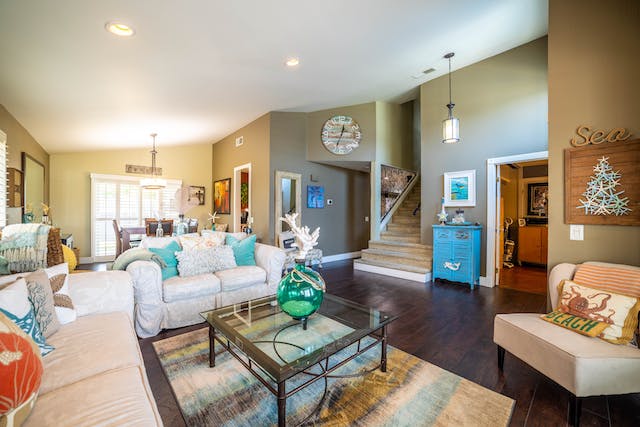Interior design thrives on creative principles, amalgamating innovative ideas, aesthetics, and functionality. These concepts strategically wield colours, textures, and spatial arrangements, evoking emotions and crafting unique atmospheres. By integrating lighting, furnishings, and architectural details, experienced interior designers utilize these elements to weave narratives that captivate and uplift while meeting functionality to create spaces resonating with personal connections, emotions, and comfort.
1. Innovative Concepts
Innovative elements in interior design embody a progressive spirit, revolutionizing spaces with groundbreaking concepts and cutting-edge technologies. Hiring the best interior design company will help redefine your spatial experiences with innovations ranging from smart home integrations and adaptable furniture to biophilic designs that bridge the gap between nature and interiors.
Innovations in interior design push boundaries, introducing new forms, functionalities, and aesthetics that redefine how homeowners conceive and experience spaces. These innovations infuse spaces with fresh perspectives, fostering adaptability to changing needs and creating environments that captivate and inspire through their ingenuity and forward-thinking approach. That helps deliver novel experiences harmonising function, aesthetics, and technological advancement.
2. Expressive Elements of Interior Design
Expressive interior design elements serve as a space’s vibrant heartbeats, infusing it with character, emotion, and individuality. Through captivating artwork, daring colour palettes, or textured materials, these elements breathe life into rooms, reflecting the personal style and creating atmospheres that resonate with the senses.
Expressive elements of interior design go beyond aesthetics, stirring emotions, sparking conversations, and crafting narratives within the confines of walls. Expressive elements are soulful storytellers, transforming spaces into personalized sanctuaries that speak volumes about the inhabitants’ tastes, passions, and aspirations.
3. Functional Harmony
Interior design capitalizes on a delicate and seamless balance between practicality and aesthetics. It revolves around creating spaces where every element serves a functional purpose while contributing to the overall visual appeal.
For example, it ensures that the layout, furniture, lighting, and decor look good together and function cohesively, optimizing usability without compromising style. The principle aims to achieve a balanced environment that feels comfortable, operationally efficient, and visually pleasing, enhancing the functionality of a space while maintaining a harmonious design aesthetic.
4. Transformative Impact
Professional interior design holds the power to create transformative designs that transcend ordinary spaces, infusing them with vitality and distinct character. The expertise goes beyond conventional decor by crafting environments that influence behaviors, attitudes, and perceptions. It’s about creating a narrative within spaces, curating an inspiring atmosphere that reflects individuality and purpose.
By harmonizing aesthetics, functionality, and personal taste, professional interior design breathes life into rooms, making them resonate with emotion and creativity. Ultimately, this transformation elevates spaces from mere rooms to personalized, inspiring, and engaging realms that captivate and enhance the human experience.
5. Principle of Lighting Philosophy
The principle of lighting philosophy in interior design revolves around the strategic use of lighting to craft ambiance, functionality, and mood within a space. It encompasses carefully selecting lighting fixtures, placement, intensity, and colour temperature to accentuate architectural elements, highlights focal points, and create desired atmospheres.
Experienced interior design professionals utilize lighting principles to define the mood, enhance visual appeal, and influence human perception within a space. By understanding the interplay of natural and artificial light, interior designers harness this principle to evoke emotions, improve functionality, and ensure optimal illumination for various activities.
In conclusion, professional interior design encapsulates a holistic journey, transforming spaces from mundane to captivating, be it an office, a residential haven, or an expansive commercial complex. The essence lies in identifying an experienced and reliable interior design company capable of curating bespoke environments. From concept inception to the final flourish, these experts harmonise functionality, aesthetics, and personal style, breathing life into spaces. Choosing the right interior designer ensures the seamless integration of innovation, creativity, and functionality, unlocking the true potential of any space and creating a personalized haven tailored to individual needs and aspirations.

